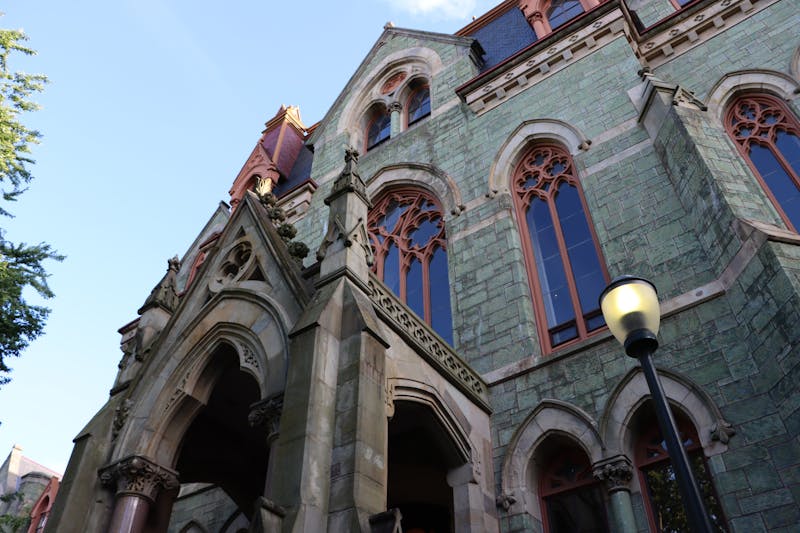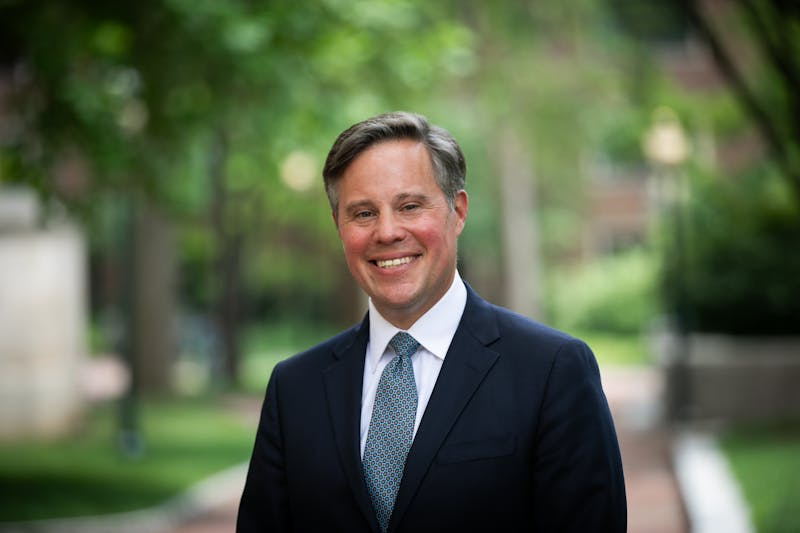
The group might have been small, but the issues were huge at yesterday's Civic House discussion regarding the origins of current relations between Penn and West Philadelphia.
For decades -- since Penn essentially bulldozed a neighborhood to permit westward expansion from 37th Street to 40th Street -- some University neighbors have cried "gentrification" in response to Penn's efforts to revitalize a deteriorating community.
But History Professor Walter Licht refuted the notion that residents will become wholly displaced, or that the area will become "lily-white."
Licht began his lecture by discussing the founding of Pennsylvania in colonial times.
From its founding in the late 17th century until the 1870s, West Philadelphia was farmland.
Eventually, the Walnut Street and Market Street bridges were constructed, opening up West Philadelphia to suburban development, Licht said.
The University began working with the city to purchase the land on which College Hall now sits in order to escape the urbanization surrounding its original buildings at Fifth and Arch streets.
"In return for this land... the University [agreed] to bring in worthy, poor youngsters from the city" and provide them with a free education at Penn, Licht said. Today, these students are called "Mayor's Scholars."
This clause in Penn's 1870 purchasing plan comes back to haunt the University every couple of decades, Licht continued. The last time it "reared its head" was during the civil rights upheavals of the 1970s and 1980s.
The issue tends to arise in conjunction with black mobilization and political involvement, Licht said.
And race has almost always been an undercurrent of social issues in the community.
As West Philadelphia became more suburban, its population came to be dominated by white middle-class families.
Slowly, the demography shifted in the 1920s and 1930s as a result of block-building and the construction of bus lines. A massive project to build a subway system in Philadelphia drew blacks north in the "Great Migration" during the Depression and the subsequent World Wars, Licht said.
In the 1930s, "you begin to get white flight to the 'burbs," he said. Owners of single-family homes left the area, but retained ownership, dividing the houses into apartments. An era of absentee landlordism and the deterioration of housing stock continued well into the 1940s and 1950s, Licht said.
This "crisis of West Philadelphia" presented a problem for the University, whose viability "rests on the viability of its surrounding community," he continued.
At mid-century, some trustees recommended moving the "University of Pennsylvania [to] Valley Forge."
However, others saw an opportunity for "do-goodism," Licht said, and "in the name of progress, the name of everyone's good," Penn embarked on a plan for redevelopment.
"The University claimed 37th to 40th streets and Spruce to Walnut streets for its own purposes," giving very small subsidies to homeowners on those corridors so that they would move out.
"To this day, [many] remember 1958, '59 and displacement," he said.
As Penn's population tripled in the 1960s, dormitories sprouted up from what was once a neighborhood. Additionally, Penn essentially "mowed down a community" to build a science corridor down Market Street.
Whether it was displacement or development, it didn't end in the 1960s.
The mid-1980s saw "a real deterioration in the quality of life in American cities," Licht said.
West Philadelphia saw the flight of the black and white middle classes, and the University faced difficulties convincing new faculty and staff to come to the University and retaining current faculty and staff.
In the early 1990s, a raft of community groups rallied around the idea of revitalization, and various suggestions were made. Still, there was "no wherewithal" to make these ideas materialize.
When Judith Rodin assumed the presidency in 1993, she took the concepts developed by various groups formed within the community and the University, and began stabilizing and revitalizing the area, Licht said.
Now, there is "no trouble convincing faculty and staff to stay" or new personnel to come, he continued. Real estate values have tripled, and finding housing sometimes presents a problem -- West Philadelphia's desirability has skyrocketed.
But while the community has seen massive improvements in terms of safety and attractiveness, there is "residual anger" from Penn's aggressive move west 35 years ago, Licht said.
"Some of it is over process," he said. "Announcements were made without real consultations" with community members. The whole development "looked very high-handed and imperial."
He added that the announcement for the Sadie Mossell Tanner Alexander-University of Pennsylvania Partnership School "came out of nowhere." And some of the promises associated with its conception have yet to come to fruition.
The school was intended to be a "hub for major education initiatives," Licht said. Instead, the promised teacher resource center has yet to be built, and the school has "drained off the white population out of Powelton Village," he added.
"The dream of sponsoring major improvements to satellite schools -- that's not going to happen," Licht said. As a result, mistrust between Penn and the community has yet to be assuaged.
College sophomore Sarah Bertozzi called Licht's presentation "really informative and interesting."
"There are so many community groups on campus and there's so much outreach... but still... a lot of the student body has no idea what's going on," she said.
"There's not that much information out there about the history of the community."
"I have a fairly cynical view of [the development], which isn't really fair, because I'm obviously benefiting," she added. "The community projects [Penn is] doing now... they could do a better job... [and] help benefit people beyond just the school."
The Daily Pennsylvanian is an independent, student-run newspaper. Please consider making a donation to support the coverage that shapes the University. Your generosity ensures a future of strong journalism at Penn.
DonatePlease note All comments are eligible for publication in The Daily Pennsylvanian.







